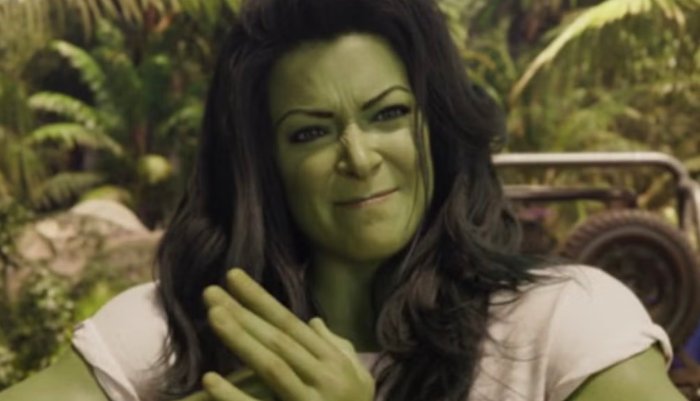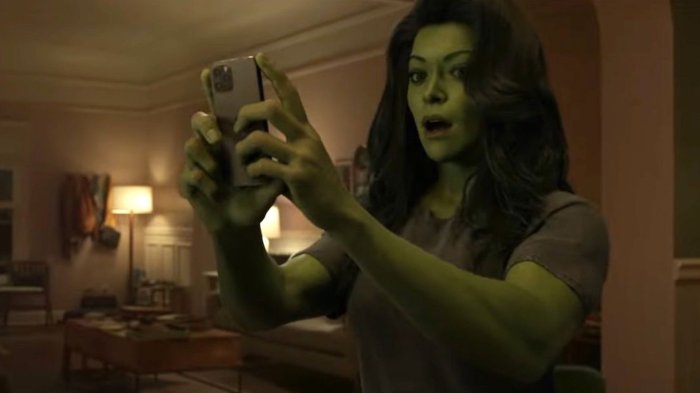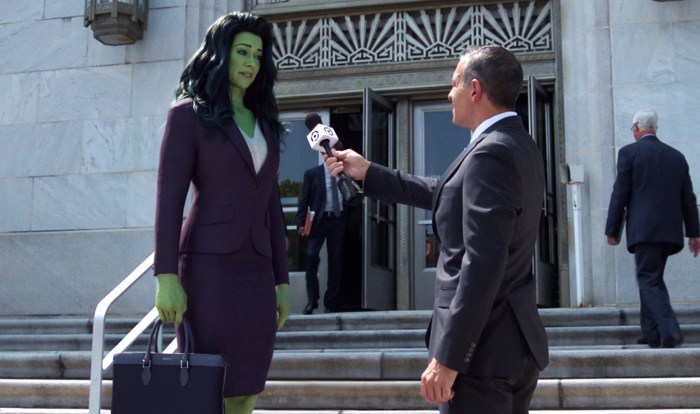Marvel’s “She-Hulk: Attorney at Law” sparked significant discussion regarding its CGI, particularly its depiction of the titular character. This analysis delves into the technical aspects of She-Hulk’s CGI, comparing its style to other MCU productions, examining audience reception, and ultimately assessing its impact on the show’s narrative and overall success. We will explore the challenges faced in rendering a character of She-Hulk’s size and unique abilities, the software and techniques likely employed, and the resulting balance (or imbalance) between realism and stylized visuals.
From the initial episodes to the finale, we’ll trace the evolution of She-Hulk’s CGI, noting any noticeable changes in technique or quality. This examination will incorporate both positive and negative feedback from viewers and critics, offering a comprehensive overview of this highly debated element of the series. We aim to provide a nuanced perspective, considering both the technical achievements and the subjective viewer experience.
She-Hulk CGI Style Comparisons
She-Hulk: Attorney at Law presented a unique visual style within the Marvel Cinematic Universe, sparking considerable discussion regarding its CGI approach. This analysis compares and contrasts the show’s CGI with other MCU productions, examining its evolution throughout the series and assessing the effectiveness of various techniques employed.
She-Hulk CGI Style Compared to Other MCU Shows
The CGI in She-Hulk differs noticeably from other MCU shows, particularly in its approach to character rendering and animation. Shows like WandaVision and Loki utilized CGI primarily for special effects and fantastical elements, maintaining a largely realistic aesthetic for their human characters. In contrast, She-Hulk embraces a more stylized, almost cartoonish rendering of its titular character, Jennifer Walters, even in scenes with a more grounded, everyday setting. This stylistic choice is most evident in the exaggerated expressions and fluid, almost bouncy, movements of She-Hulk, compared to the more subtly animated characters in other MCU productions. For example, the fight choreography in She-Hulk features more dynamic and less realistically weighted movements than the combat scenes in shows like Falcon and the Winter Soldier. The opening scene of episode one, where Jennifer is involved in a car accident, demonstrates the stylistic difference clearly. The accident itself is rendered realistically, but Jennifer’s transformation and subsequent actions as She-Hulk are noticeably more cartoonish and less grounded in physical reality.
Evolution of She-Hulk’s CGI Throughout the Series
The CGI used for She-Hulk evolved subtly throughout the series. In the earlier episodes, some viewers noted a slightly inconsistent rendering of her skin texture and musculature, particularly in close-ups. These inconsistencies seemed to lessen in later episodes, suggesting refinements in the rendering techniques and potentially an adjustment to the lighting and rendering parameters. Furthermore, the animation style itself seemed to find a more consistent rhythm as the season progressed, with the initially slightly jerky movements smoothing out into a more fluid and natural animation style, though maintaining the characteristic exaggerated expressiveness. A clear example of this evolution can be seen by comparing She-Hulk’s appearance and movement in the courtroom scenes of the first episode to her appearance in the final confrontation.
Comparative Analysis of CGI Techniques in She-Hulk
The following table details various CGI techniques used in She-Hulk, assessing their visual impact and overall success:
| Technique | Scene Example | Visual Impact | Overall Success |
|---|---|---|---|
| Motion Capture and Performance Capture | She-Hulk’s fight scenes | Highly dynamic and expressive movements, conveying both power and humor | Mostly successful, though some initial stiffness was noted in earlier episodes. |
| Realistic Rendering of Environments | Courtroom scenes, office scenes | Creates a believable setting that contrasts with She-Hulk’s stylized appearance. | Highly successful, contributing to the show’s unique blend of tones. |
| Stylized Character Rendering (She-Hulk) | Most scenes featuring She-Hulk | Creates a distinct visual identity for the character, reflecting her personality | Generally successful, although some inconsistencies were observed early on. |
| CGI Effects for Superpowers | She-Hulk’s strength demonstrations | Exaggerated and impactful, fitting the overall tone | Successfully enhanced the fantastical elements without detracting from the realism of other aspects. |
Technical Aspects of She-Hulk CGI

Creating a believable CGI character like She-Hulk presents unique challenges for visual effects artists. Her massive size, exaggerated proportions, and dynamic movements require a sophisticated blend of technical expertise and artistic vision to achieve a convincing portrayal within the show’s established aesthetic. The process involves a complex interplay of software, techniques, and artistic decisions.
The rendering of She-Hulk’s form and movements required considerable computational power and specialized software. The sheer scale of her musculature and the fluidity of her movements, especially during action sequences, necessitate high-polygon models and advanced rigging techniques to prevent the appearance of stiffness or unnatural motion. Her transformations, shifting between human and Hulk forms, presented an additional layer of complexity.
Software and Processes Used in She-Hulk’s CGI Creation
The creation of She-Hulk’s CGI likely involved a pipeline incorporating industry-standard software packages. Modeling software such as Maya or ZBrush would have been used to sculpt her detailed anatomy, including the subtle nuances of muscle definition and skin texture. Autodesk Maya, known for its robust animation and rigging capabilities, would have been crucial in bringing her to life. Subdivision surface modeling would have allowed for the creation of high-resolution models that could be easily manipulated and animated. Specialized software for simulation, such as Houdini, might have been used to generate realistic effects such as hair, cloth, and fluid dynamics, particularly for scenes involving water or impact. Finally, rendering software like Arnold or RenderMan would have produced the final high-quality images, applying advanced lighting and shading techniques to create a cohesive visual style. The process would have involved numerous iterations of modeling, rigging, animation, and rendering, with constant feedback and adjustments throughout.
Balancing Realism and Stylized Look
Achieving a balance between realism and the show’s stylized aesthetic was a key challenge. While She-Hulk’s anatomy is exaggerated compared to a real-world human, the CGI team needed to maintain a level of believability. This likely involved careful consideration of lighting, shading, and texturing. The use of subtle cel-shading techniques, possibly combined with advanced subsurface scattering effects, could have been employed to give her skin a slightly cartoonish yet still visually appealing texture, preventing her from appearing overly realistic and potentially jarring within the context of the show. The style of animation, including the use of exaggerated poses and movements, further contributed to this balance, allowing for dynamic action while maintaining a consistency with the overall aesthetic of the series. The team likely experimented with different rendering styles and levels of detail to find the optimal balance. For instance, close-up shots might have employed higher levels of detail and realism, while long shots might have used more stylized rendering to maintain performance efficiency. The decision to render her in a more stylized manner was crucial in avoiding the “uncanny valley” effect, which often occurs when CGI characters appear almost but not quite realistic.
Audience Reception of She-Hulk CGI

The CGI in She-Hulk: Attorney at Law generated a wide spectrum of reactions online, ranging from enthusiastic praise to harsh criticism. This varied response highlights the subjective nature of visual effects appreciation and the complexities of achieving a consistent, high-quality result across a full season of television. The debate surrounding the show’s CGI also offers a valuable case study in how audience perception can be influenced by factors beyond purely technical merit.
The reception of She-Hulk’s CGI can be broadly categorized into three main groups: positive, mixed, and negative. Positive reviews often highlighted the show’s stylistic choices, emphasizing its unique approach to integrating CGI characters into live-action scenes. Mixed reviews acknowledged both the strengths and weaknesses of the visual effects, often pointing to inconsistencies in quality across different episodes or scenes. Negative reviews, on the other hand, were highly critical, focusing on perceived flaws in the rendering of characters and environments.
Categorization of Online Opinions on She-Hulk CGI
Online discussions surrounding She-Hulk’s CGI reveal a clear division of opinion. Proponents often praised the show’s commitment to a distinct, almost cartoonish aesthetic, arguing that this style complemented the show’s comedic tone and helped to distinguish it from other superhero shows. Conversely, critics frequently pointed to instances where the CGI appeared unnatural or jarring, particularly in comparison to the photorealistic visuals often seen in major motion pictures. Many comments centered on the perceived inconsistencies in the quality of the CGI throughout the series, with some scenes receiving far more praise than others. This inconsistency contributed significantly to the mixed reception. A significant portion of the online conversation also focused on comparisons with other Marvel Cinematic Universe (MCU) projects, often citing differences in style and execution.
Comparison with CGI in Other Recent Television Shows
She-Hulk’s CGI reception differs significantly from that of other recent television shows with comparable visual effects budgets and ambitions. While shows like “The Mandalorian” have generally received widespread praise for their high-quality CGI, often described as groundbreaking for television, She-Hulk’s reception has been much more divisive. This disparity might stem from differing stylistic choices; “The Mandalorian’s” CGI aims for a more realistic, albeit stylized, look, while She-Hulk embraces a more overtly artificial aesthetic. This stylistic divergence significantly influences audience perception, as viewers accustomed to photorealistic CGI may find She-Hulk’s style jarring, while others may appreciate its unique approach. The difference in overall tone and genre between the two shows also plays a role; the more serious tone of “The Mandalorian” may lend itself better to a more realistic visual style than the comedic tone of She-Hulk.
Specific Criticisms and Praise of She-Hulk CGI
The following points summarize specific criticisms and praise regarding the CGI in She-Hulk: Attorney at Law.
- Praise: The stylistic consistency and commitment to a distinct, cartoonish aesthetic was appreciated by many viewers. This approach was seen as fitting for the show’s comedic tone and character design. The seamless integration of CGI elements into live-action scenes was also highlighted in positive reviews. Many found the exaggerated features of She-Hulk’s CGI to be charming and appropriate to her character.
- Criticism: Inconsistencies in CGI quality across different episodes and scenes were frequently cited. Some viewers found the rendering of She-Hulk’s skin and hair to be unnatural or unconvincing in certain shots. The CGI was sometimes criticized for appearing less polished than the visual effects in other recent MCU projects, leading to a sense of uneven quality across the Marvel Cinematic Universe. The inconsistent lighting and rendering of her face also drew considerable criticism.
Illustrative Examples of She-Hulk CGI
The CGI in She-Hulk: Attorney at Law presents a mixed bag, showcasing both impressive feats of visual effects and instances where the technology falls short. Analyzing specific scenes helps illustrate the spectrum of the show’s CGI quality and its impact on the overall viewing experience. The following examples highlight both successes and areas for improvement.
A Scene Where She-Hulk’s CGI is Particularly Effective
The courtroom scenes featuring She-Hulk often demonstrate the show’s CGI strengths. In particular, a scene where She-Hulk is cross-examining a witness stands out. The CGI convincingly integrates her larger-than-life form into the relatively normal-sized courtroom. The lighting is carefully balanced, ensuring that She-Hulk doesn’t appear overly bright or out of place against the more muted tones of the courtroom setting. Her movements are fluid and realistic, her expressions subtle yet powerful, and her interaction with the other characters (all human-sized) is believable. The textures of her skin and costume are detailed, showcasing a convincing blend of human-like realism and super-powered strength. This careful integration of CGI into a practical set enhances the scene’s believability and contributes to the overall effectiveness of the storytelling.
A Scene Where She-Hulk’s CGI is Less Successful
In contrast, some of She-Hulk’s action sequences display noticeable inconsistencies. A particular fight scene involving multiple opponents showed noticeable inconsistencies in the rendering of her musculature and movement. During rapid movements, her form sometimes appeared slightly distorted or lacked the expected fluidity, creating a jarring disconnect between the action and the visual representation. The level of detail in her skin texture also seemed to fluctuate, appearing smoother in some shots and more detailed in others, creating a lack of visual consistency. This inconsistency in the quality of the CGI detracted from the scene’s impact and potentially lessened the viewer’s immersion in the action.
She-Hulk’s Transformation Scene
She-Hulk’s transformation scenes typically begin with Jennifer Walters experiencing intense stress or physical exertion. The lighting shifts subtly, becoming slightly more saturated and intense as the transformation commences. The initial changes are subtle: veins become more prominent, her muscles visibly tense and enlarge. The texture of her skin appears to tighten and become slightly more reflective. The transformation itself is not instantaneous; it’s a dynamic process, depicted with a morphing effect that blends her human form into her She-Hulk form. The movement is not jerky or abrupt; instead, it’s a fluid transition, showcasing a gradual shift in her proportions and physique. The final result is a convincingly powerful and larger-than-life She-Hulk, her skin exhibiting a slightly more vibrant green hue and her musculature defined and powerful. The lighting plays a crucial role, highlighting the changes in her form and emphasizing her newfound strength.
Ending Remarks

Ultimately, the CGI in “She-Hulk: Attorney at Law” presents a complex case study in visual effects for a superhero series. While the technical challenges of rendering a character like She-Hulk are undeniable, the varying audience reception highlights the subjective nature of CGI evaluation. The effectiveness of the CGI is inextricably linked to its role in the narrative, enhancing comedic moments while occasionally detracting from the overall realism. Further analysis into the specific techniques and their application across different scenes offers a clearer picture of both the successes and shortcomings of this ambitious visual undertaking.
Commonly Asked Questions
What software was likely used to create She-Hulk’s CGI?
While specifics aren’t publicly available, industry-standard software like Autodesk Maya, Houdini, and various compositing programs were likely utilized.
How does She-Hulk’s CGI compare to other female superhero portrayals in the MCU?
Comparisons vary. Some argue She-Hulk’s CGI is less polished than other MCU characters, while others find her unique style fitting for the show’s tone.
Did the CGI impact the show’s budget significantly?
The exact budget impact isn’t public knowledge, but rendering a character like She-Hulk undoubtedly required significant resources and expertise.